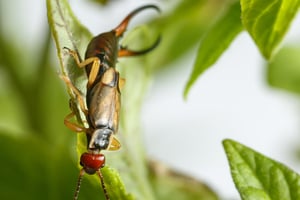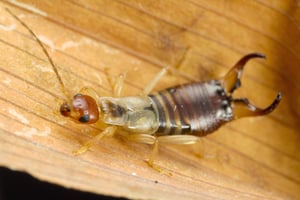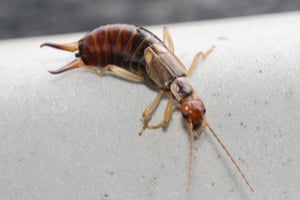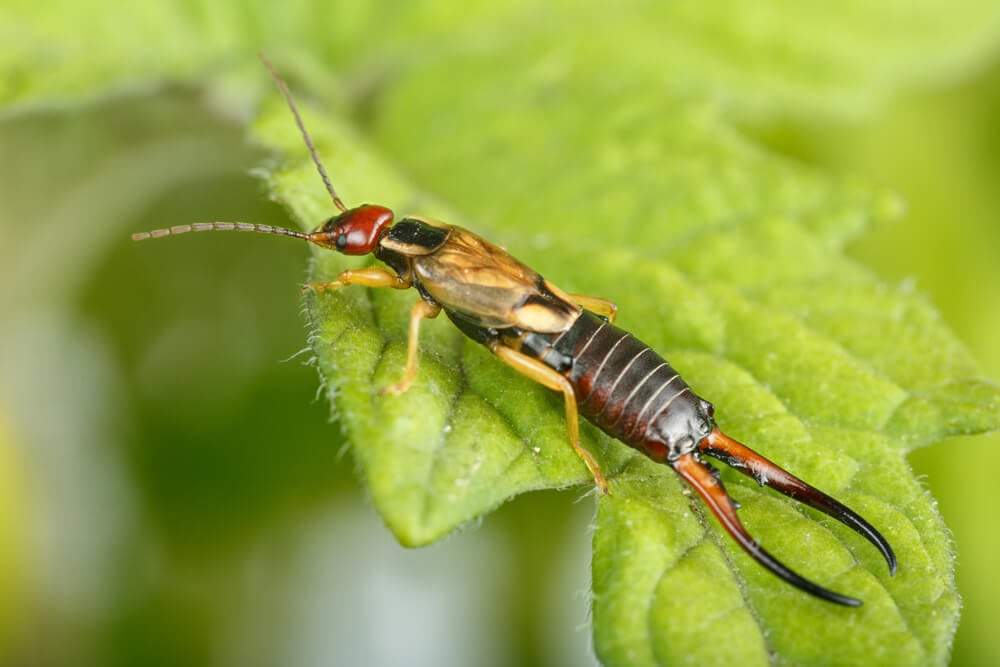What They Are
 Earwigs are a nocturnal, omnivorous insect making up the insect order “Dermaptera”. There are around 2000 species of earwigs in 12 families. A common misconception about earwigs is that their name comes from a tendency to nest inside human ears. Fortunately, that isn’t true. The name actually refers to the insects’ wings, which resemble the shape of a human ear when unfolded.
The most common earwig encountered in the US is the Forificula auricularia, or the European Earwig. This insect is around ⅝ inches long, dark red or brown, and has short wings and long antennae. Earwigs have distinctive large, powerful-looking pincers (also called “forceps” or “cerci”) on the tip of their abdomens. They mostly use their pincers for self-defense, but they’ll occasionally use them to capture prey, as well. Earwigs occasionally use their pincers on humans, but they can’t clamp down strong enough to do serious damage.
Earwigs are a nocturnal, omnivorous insect making up the insect order “Dermaptera”. There are around 2000 species of earwigs in 12 families. A common misconception about earwigs is that their name comes from a tendency to nest inside human ears. Fortunately, that isn’t true. The name actually refers to the insects’ wings, which resemble the shape of a human ear when unfolded.
The most common earwig encountered in the US is the Forificula auricularia, or the European Earwig. This insect is around ⅝ inches long, dark red or brown, and has short wings and long antennae. Earwigs have distinctive large, powerful-looking pincers (also called “forceps” or “cerci”) on the tip of their abdomens. They mostly use their pincers for self-defense, but they’ll occasionally use them to capture prey, as well. Earwigs occasionally use their pincers on humans, but they can’t clamp down strong enough to do serious damage.
Where They Came From
 As the name implies, the European Earwig is native to Europe. The pest showed up here relatively recently: they were first observed in the US in 1907, in Seattle. According to experts, European Earwigs probably came overseas along with the plant nursery trade. Planters transporting trees or flower beds inadvertently provided transportation for earwigs stowing away in the bottom of their pots. After the planters successfully migrated their plants, the pests were free to spread out on a new continent.
Earwigs came to the Midwest even more recently, arriving in Wisconsin in the ‘80s and Minnesota in the early 1990s. The winged insects rarely fly, but they’re very good at hitching rides along with travelers or movers. They proliferated around the US mostly by hiding in transported bags of food, wood, or other materials. It only takes a few earwigs to create a new, permanent population in another area.
As the name implies, the European Earwig is native to Europe. The pest showed up here relatively recently: they were first observed in the US in 1907, in Seattle. According to experts, European Earwigs probably came overseas along with the plant nursery trade. Planters transporting trees or flower beds inadvertently provided transportation for earwigs stowing away in the bottom of their pots. After the planters successfully migrated their plants, the pests were free to spread out on a new continent.
Earwigs came to the Midwest even more recently, arriving in Wisconsin in the ‘80s and Minnesota in the early 1990s. The winged insects rarely fly, but they’re very good at hitching rides along with travelers or movers. They proliferated around the US mostly by hiding in transported bags of food, wood, or other materials. It only takes a few earwigs to create a new, permanent population in another area.
What They Want
 Earwigs are nocturnal and spend their days hiding in dark, hidden, and preferably moist areas. They’re attracted to dampness and humidity, especially in dark and secluded places. Their flat bodies let earwigs crawl under cover easily, so they’re commonly found under floorboards, rocks, furniture, or boxes. When they enter home it’s usually not on purpose. It just so happens your home provided a dark, damp place for them to hide.
Indoors, earwigs are largely harmless. They don’t eat food, damage structures, hurt property, or reproduce. They will go anywhere they can hide, however, including laundry baskets, pantries, or other sensitive areas. When earwigs get inside, they tend to come in droves. Though they don’t eat much human food, it’s possible they will be attracted to rotting or unprotected fruit. Earwigs are more likely to infest homes near their preferred outdoor environments. They’re attracted to damp gardens, flowers, and dying plant life.
Earwigs are nocturnal and spend their days hiding in dark, hidden, and preferably moist areas. They’re attracted to dampness and humidity, especially in dark and secluded places. Their flat bodies let earwigs crawl under cover easily, so they’re commonly found under floorboards, rocks, furniture, or boxes. When they enter home it’s usually not on purpose. It just so happens your home provided a dark, damp place for them to hide.
Indoors, earwigs are largely harmless. They don’t eat food, damage structures, hurt property, or reproduce. They will go anywhere they can hide, however, including laundry baskets, pantries, or other sensitive areas. When earwigs get inside, they tend to come in droves. Though they don’t eat much human food, it’s possible they will be attracted to rotting or unprotected fruit. Earwigs are more likely to infest homes near their preferred outdoor environments. They’re attracted to damp gardens, flowers, and dying plant life.
What We Can Do About Them
 Earwigs come into homes to get three things: darkness, shelter, and moisture. If you want to keep them out, you have to make sure they can’t get these things. The pest tends to infest basements, attics, crawl spaces, and dark storage areas, so start there. First, look for any sources of excess humidity. Drafts, plumbing leaks, puddles, draining water, condensation, or even stale air can all lead to indoor humidity. Address any problems you find and invest in a dehumidifier to eliminate the moisture consideration.
Depriving these obnoxious buggers of their darkness and shelter won’t be quite as hard as it sounds. Start by simply tidying up the areas where they tend to live. Elevate stored boxes off the ground in your basement. Clear out debris or clutter from storage areas. Patch up cracks in the floor or torn insulation. If earwigs don’t have a place to hide, they won’t feel as comfortable exploring your home at night.
Like most pests, earwigs look a lot scarier than they really are. The truth is, earwigs can’t do much to hurt you or your home, even in army-like numbers. That… probably won’t comfort you much if you run into the pincered-pests on some dark and spooky night, however.
If that ever happens to you, be comforted by the fact that Plunkett’s will always have your back. Just give us a call anytime and we’ll find your pests and flush them out of your home, permanently.
Earwigs come into homes to get three things: darkness, shelter, and moisture. If you want to keep them out, you have to make sure they can’t get these things. The pest tends to infest basements, attics, crawl spaces, and dark storage areas, so start there. First, look for any sources of excess humidity. Drafts, plumbing leaks, puddles, draining water, condensation, or even stale air can all lead to indoor humidity. Address any problems you find and invest in a dehumidifier to eliminate the moisture consideration.
Depriving these obnoxious buggers of their darkness and shelter won’t be quite as hard as it sounds. Start by simply tidying up the areas where they tend to live. Elevate stored boxes off the ground in your basement. Clear out debris or clutter from storage areas. Patch up cracks in the floor or torn insulation. If earwigs don’t have a place to hide, they won’t feel as comfortable exploring your home at night.
Like most pests, earwigs look a lot scarier than they really are. The truth is, earwigs can’t do much to hurt you or your home, even in army-like numbers. That… probably won’t comfort you much if you run into the pincered-pests on some dark and spooky night, however.
If that ever happens to you, be comforted by the fact that Plunkett’s will always have your back. Just give us a call anytime and we’ll find your pests and flush them out of your home, permanently.









